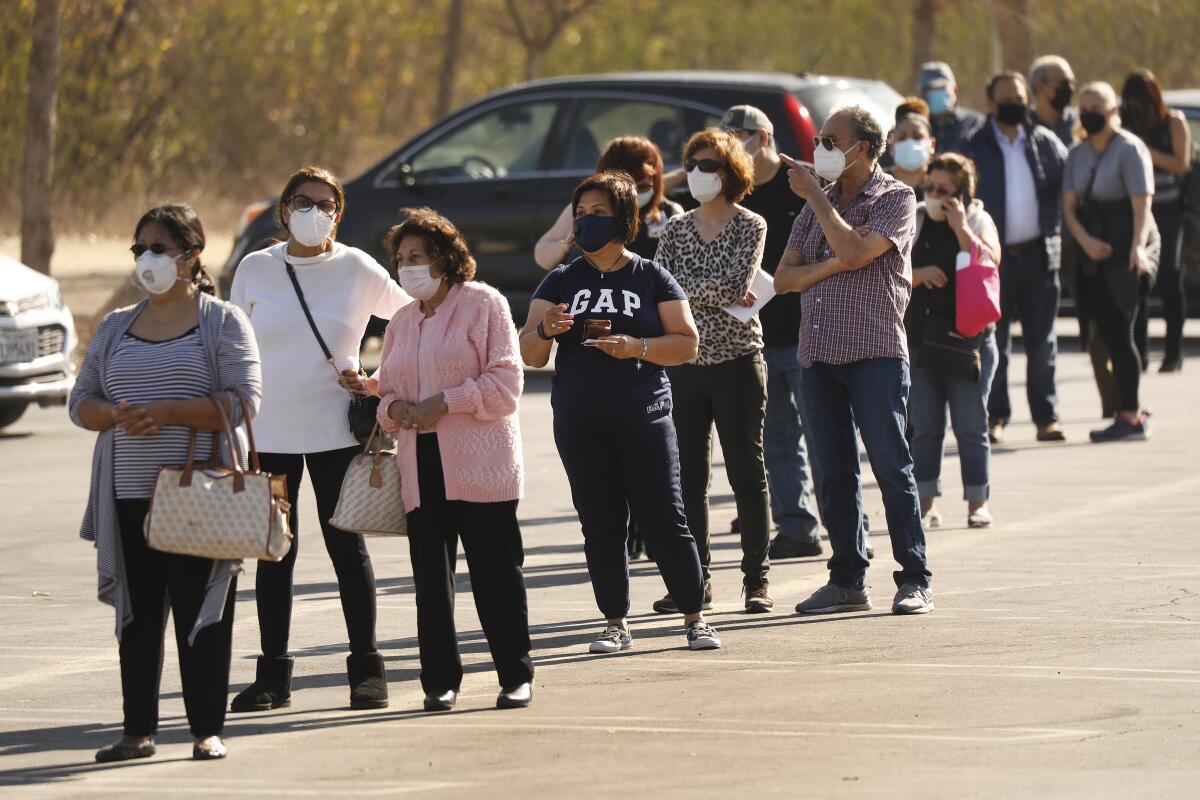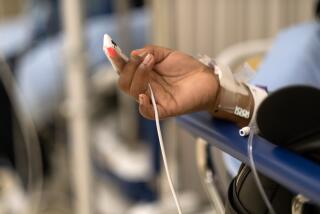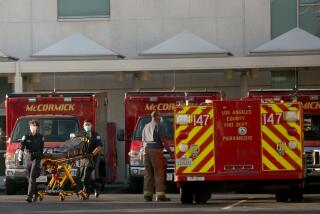Did L.A.’s COVID-19 hospital surge cause unnecessary deaths? ‘The public deserves an answer.’

During the worst moments of the autumn-and-winter coronavirus surge in Southern California, doctors and nurses frantically trying to save patients at overcrowded hospitals made terrifying warnings about what they were seeing.
“Everything is such a disaster now,” one doctor at an L.A. County hospital said in January. “Patients are dying due to a lack of staffing and lack of attention.”
“It’s a nightmare for every hospital,” said an ER nurse, as hospitals overflowed with patients, ambulances waited hours for beds to open up and hospitals struggled to fix pipes needed to send oxygen for patients gasping for breath.
But now as coronavirus cases fall and hospitals are finally seeing some relief, it remains an open question as to whether the unprecedented surge in COVID-19 patients led to a widespread increase in the risk of dying.
“Frankly, the public deserves an answer to the question. So I think there will be a lot of effort to get it,” said Dr. Roger Lewis, an emergency physician at Harbor-UCLA Medical Center in West Carson and director of COVID-19 hospital demand modeling for the L.A. County Department of Health Services. “This is a type of analysis and transparency that the public deserves, and that people should be clamoring for.”
Clearly, more people died of COVID-19 during the surge because the virus became far more widespread — since Nov. 1, more than 12,000 COVID-19 deaths in L.A. County have been reported, a majority of the cumulative 19,000 deaths that have been reported so far. It remains unclear, however, whether a person who entered the hospital was more likely to die during the autumn-and-winter surge than if they had entered the hospital in the same severity of illness earlier in the year.
Many healthcare providers reported feeling distraught as sick patients who would have otherwise been treated at their hospitals had to be sent to other facilities farther away. But conclusively determining whether scattered reports of problems led to an increase in the risk of dying is something officials are still trying to work out.
There are multiple teams of scientists who are trying to answer this question, including among county health experts, officials say.
“You would think: There’s more people lying there with less nurses and people to care for them, then there’s got to be some bad outcomes,” said Cathy Chidester, director of the county’s Emergency Medical Services Agency. “It makes common sense that if it took people longer to get into the [emergency department] or seen by a physician or longer to get the remdesivir because there were so many people in front of them, then their outcomes would be worse. That’s common sense.”
Despite teetering close to the edge, no hospital in L.A. County formally declared to government officials they were forced to operate under “crisis standards of care” and had to ration healthcare, which would have meant that doctors decided which patients would not receive the most aggressive lifesaving treatment in order to focus resources on people most likely to benefit.
Officials have said that healthcare was beginning to become compromised during the autumn-and-winter surge. In Lynwood, there was one report of doctors arguing about whether an elderly patient should be hooked up to one of the few remaining ventilators at a hospital. L.A. County officials reported delays in getting heart attack and stroke patients into hospitals. And to deal with a shortage of nurses, officials dispatched staff with little experience in hospitals to help out.
“They had deployed nurses who haven’t taken care of patients in over 10 years,” said an ICU nurse at a public L.A. hospital, who said she and another nurse were watching over five patients who could “ crash at any second,” far more than was comfortable. “It’s really scary.”
But experts say it will probably take months or even a year or so to understand whether patients were substantially harmed by less-effective care in overburdened hospitals. Researchers would need to account for the condition of each patient coming into the hospital, as well as their risk factors, such as diabetes or high blood pressure, and compare their outcomes to those of similar patients with equally severe illness at other points during the pandemic, Lewis said.
Early numbers don’t offer a complete picture. In the two months before the fall-and-winter surge, 12% of COVID-19 patients admitted to hospitals in L.A. County died, according to an analysis by the L.A. County Department of Health Services. Between Nov. 3 and Jan. 20, the percentage of hospitalized COVID-19 patients who died had nearly doubled to 23%, the analysis found.
But the figure is not believed to reflect that the quality of healthcare dropped during the surge; rather, the increased percentage of deaths is more likely a result of hospitals being so crowded that only the sickest patients were being admitted, Lewis said. Because hospitalized COVID-19 patients had become uniformly more severely ill, a greater percentage of them were dying.
Scientists are also expected to study whether the risk of death worsened for non-COVID patients.
Some heart attack and stroke patients sent by ambulance faced delays getting into overcrowded hospitals, Chidester said.
Others put off necessary medical care for fear of contracting the coronavirus at the hospital.
“We had a lady who walked in and had a stroke in the lobby,” said St. Francis Medical Center ICU nurse Scott Byington, who said that many patients without COVID-19 delayed urgent care during the surge.
When stroke and heart attack patients did make it into the hospital, their care was often delayed. Typically, such patients would be immediately met by a special team of providers to get quick treatment and a CAT scan, Chidester said. But that sometimes wasn’t happening when the hospitals were overloaded, she said, which may have led to worse outcomes because the treatments are time-sensitive, she said.
“They weren’t rushing patients in because there was absolutely no beds for them. They were having to sit on the wall like the COVID-19 patients and not getting the rapid interventions we would’ve liked to see,” she said.
The crush of patients countywide forced hospitals to sometimes place patients in conference rooms and gift shops. There were many days during the surge when virtually every hospital in the county was on diversion at some point.
UCLA ER nurse Marcia Santini recalled that during at least one hospital shift, every hospital in L.A. County was reporting that its ER was saturated and could not take more ambulance patients. “It’s really a true nightmare because you’re being forced to do things you would never do.”
Still, it’s also plausible that L.A. County narrowly avoided tipping into a widespread worsening of the risk of dying. It’s possible that, while there may be some examples of poor quality of care as a result of the surge, it did not become widespread.
That’s the opinion Lewis offered, based on his experience working as an emergency physician at Harbor-UCLA and what he’s heard from other hospitals in the L.A. area. “My opinion ... is that we came very, very close to having our hospital system across Los Angeles County overwhelmed to the point where it was unable to save lives that would have otherwise been saved in a different setting,” Lewis said.
There are other places in the world where experts suspect hospital overcrowding contributed to a high mortality rate, such as in Wuhan, China and in northern Italy in the early months of the pandemic, said Dr. Robert Kim-Farley, medical epidemiologist and infectious diseases expert at the UCLA Fielding School of Public Health.
But the fact that L.A.’s worst surge hit during the fall and winter may have improved a patient’s chances of surviving COVID-19 simply by virtue of its occurring months after doctors worldwide had developed a better understanding about how to treat the disease.
“I think that — even with the surge that we saw in the winter — that the case-fatality rate for each age group is probably improving because of our improved ability to care for patients,” such as knowing to avoid placing patients on ventilators as much as possible, placing patients on their bellies to make it easier for them to breathe and discoveries of certain types of drugs that can improve outcomes, Kim-Farley said.
Some of those improvements in treatments triggered new problems. Doctors and nurses have learned since the early days of the pandemic to, as much as possible, avoid placing patients on ventilators, which generally requires sedation and involves sticking a plastic tube through the mouth into the windpipe to deliver oxygen to the lungs.
Many patients instead receive a high-flow oxygen treatment, in which oxygen is sent through plastic tubes placed into the nose. While a non-COVID patient may receive six liters of oxygen per minute, COVID-19 patients need 60 to 80 liters a minute. That placed a tremendous amount of burden on oxygen delivery systems.
The high demand for oxygen led to problems at aging hospitals, where the demand for oxygen was unprecedented. At some hospitals where oxygen pipes froze, the problem was eventually fixed by installing fans or sprinklers to prevent freezing.
“We got those resolved, but by the time we get it resolved it’s like a week later,” Chidester said. “A lot of things we did were really, really good. Unfortunately, they were a little bit behind.”
Times staff writer Samantha Masunaga contributed to this report.
More to Read
Start your day right
Sign up for Essential California for news, features and recommendations from the L.A. Times and beyond in your inbox six days a week.
You may occasionally receive promotional content from the Los Angeles Times.








